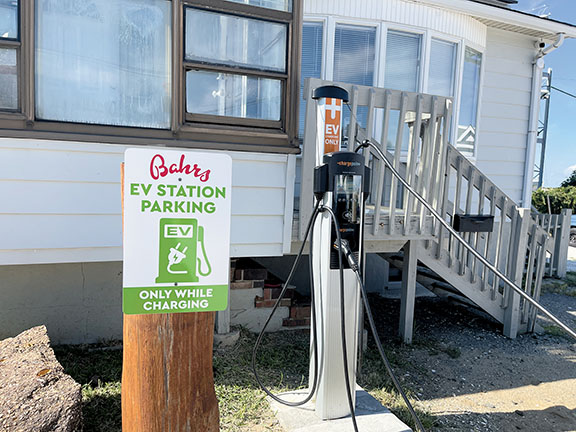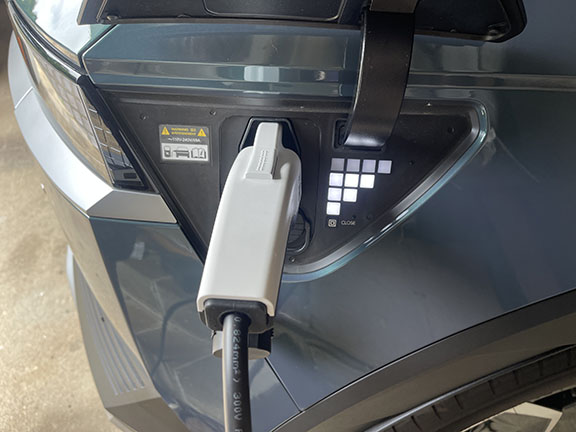
By Elizabeth Wulfhorst
Two years after Gov. Phil Murphy signed landmark electric vehicle (EV) legislation, the state has expanded incentive programs for buyers, public charging stations, residential chargers and more.
As Joseph Fiordaliso, president of the New Jersey Board of Public Utilities (NJBPU), explained it, “Forty percent of the carbon we emit into the air comes from transportation. So it’s vital, if we’re going to mitigate the effects of climate change, that we attack the transportation sector.”
That comes in the form of increased money for the purchase of EVs, and for businesses, municipalities and utility companies to continue encouraging clean energy, all in addition to the potential $7,500 federal tax credit offered to many EV buyers.
The state EV law provides for at least $30 million annually for the Charge Up New Jersey program for a period of 10 years. In fiscal year 2023, NJBPU budgeted $35 million for the program, but those thinking about purchasing an EV should act fast.
“The money ran out relatively quickly last year,” admitted Kelly Mooij, director, NJBPU Division of Clean Energy, which means residents are taking advantage of the state’s offers. The current point-of-sale tiered incentive gives EV buyers an immediate reduction on the cost of a car, based on its MSRP. She noted that the details of the Charge Up New Jersey program may change from year to year as NJBPU focuses on “making sure that we’re really driving the market towards adoption.”
Mooij said the state is continuing to make improvements to its website so consumers can see how much money remains in the program. “We can communicate really quickly and transparently with people so they know exactly what’s available” when purchasing a car, she said. As of this week, a little over $33.8 million, or 56% of this year’s program money remained.
The state is also once again waiving the sales tax on the purchase of an EV, which can save buyers even more money. On a $45,000 EV, savings could reach $14,481 – the $7,500 federal tax credit, the maximum $4,000 Charge Up New Jersey point-of-sale credit, and the $2,981 sales tax exemption. As more car companies expand their EV options, the vehicles will become more and more affordable. While models from Tesla and Porsche can easily top $100,000, plenty other options are available for much less than that, like the Chevy Bolt, the Mazda MX-30 and the Hyundai Kona Electric. According to the state, in the first two years of the Charge Up New Jersey program, it provided incentives for more than 13,000 vehicles.
Where to Charge?
But one of the biggest current drawbacks for EV owners and potential purchasers is the lack of public charging stations in some regions, including in parts of the Two River area. Red Bank currently has two, one near borough hall and one in English Plaza; there are six stations at Bell Works and one at Holmdel Commons in Holmdel; three in Middletown Plaza at Route 35 and Harmony Road; and a relatively new one at Bahrs Landing in Highlands, installed after a viral Super Bowl commercial showed an actor from “The Sopranos” television show parking her EV outside the restaurant to charge.
But NJBPU is addressing the dearth of public chargers in certain areas of the state – and further encouraging EV purchases – by expanding its charger incentive programs.
“The whole purpose of the charging program, in general, is to minimize the effects of range anxiety,” Fiordaliso explained. Range anxiety for an EV owner is similar to worrying about running out of gas in a combustion engine automobile. He explained that mitigating the charger concern is another step in encouraging EV ownership. “So there are incentives for private developers and our utilities to include and to build these chargers, and there’s also incentives for home chargers.”

Elizabeth Wulfhorst
For residential customers, NJBPU is offering a $250 rebate toward the purchase of a home charger – which average around $700 – with $5.5 million available for fiscal year 2023.
Utility companies are embracing the change to clean energy as well. In June, JCP&L began offering residential and commercial customers incentives through its EV Driven program. It provides up to $1,500 for electrical upgrades to a residence necessary for the installation of a Level 2 charger, up to $5,500 for utility upgrades (like poles, wires and transformers) and bill credit incentives to encourage off-peak charging. Once again, acting quickly is key: JCP&L has only allocated for 2,000 qualified Level 2 EV chargers in its service area.
EVs can be charged using three “levels” of chargers, Level 1, Level 2 and DCFC or direct current fast charging (sometimes called Level 3). Level 1 is a charge from a typical 120V household outlet and is the slowest charging option. It is sometimes called a trickle charge. At 240V, Level 2 chargers can be installed residentially with modifications, similar to installing an outlet for an electric dryer. Level 2 provides a much faster charge than Level 1 – 25 miles per hour of charge versus 4. DCFC chargers can deliver 200 miles of charging in less than 30 minutes.
“The EV Act and the EV goals that we have in the state tried to identify different aspects for us to address,” Mooij said.
“We have three great programs now that are available” with charger installation incentives, in addition to the residential rebate, she said, including the EV Tourism program, the MUD (multi-unit dwelling) program and the Clean Fleet program, which Mooij called “an exciting opportunity for towns and local governments, as well as the state.” She said the state is expecting additional funds from the federal government “for a variety of different charging opportunities” in different regions.
All the programs are focused on getting those “individuals who are trying to decide between a combustion engine vehicle and an EV, we’re trying to push them in the right direction towards helping us to achieve our clean energy goals and reduce emissions,” Mooij said.
Towns Also Taking Charge
Developers in Red Bank and Atlantic Highlands have already taken advantage of the MUD EV Charger Incentive Program, designed to encourage owners and operators of condominiums and apartment buildings to provide EV chargers for residents and guests.
Monmouth County received money from the EV Tourism program – which provides funds for chargers at tourist locations across the state – to install 12 new public charging stations, six in downtown Freehold by the Hall of Records and the County Health Department and six at Seven Presidents Oceanfront Park in Long Branch. The Atlantic Highlands Borough Council Environmental Commission also secured funds from the program to install three public chargers – two Level 2 chargers and one DCFC fast charger – in the borough, part of an area along the Route 36 corridor that council member Brian Dougherty called an “EV charger desert.” The money will be used to install the chargers, along with all the necessary utility work.
In a release, Doherty explained why EV charging stations would benefit the borough. “Any visitors coming to our area to use the beaches at Sandy Hook or Sea Bright, for example, would have to venture over to Route 35 to find a charge for their EV. When these stations are installed in Atlantic Highlands, it would be a definite attraction for visitors to frequent our restaurants and shops downtown while their vehicle is charging. And, as we all know, once people discover how wonderful Atlantic Highlands is, they will come back.”
Public charging stations can also provide revenue for a town. While rates are usually set by the company which owns the station – some popular ones include EVgo, ChargePoint, Electrify America, Volta and Tesla (which only charges Tesla models) – the town, business or school that installs the charging stations can receive a percentage of the charging fees.
“The primary purpose is to make people feel at ease and to make those folks who want to come to New Jersey and enjoy our coastline, to assure them that we have chargers here if they have an electric vehicle, so they don’t have to worry,” Fiordaliso said.
Working Toward Environmental Justice and Equity
All of the state’s programs are part of the New Jersey Energy Master Plan, a roadmap to reaching 100% clean energy by 2050.
“We’re grateful and fortunate to have an administration in Washington now that recognizes the climate change dilemma,” Fiordaliso said. And he noted that utility companies in the state have been working to ensure the electric grid stands up to the test of increased consumption from EVs.
“We are in a revolution, an energy revolution, an energy generation revolution,” he said. “We’re going to be generating, hopefully, in the not too distant future, energy from clean sources, and they (utility companies) recognize that and they’re prepared for that.” Fiordaliso noted some have already invested in clean energy like solar and off-shore wind transmission. “They see the handwriting on the wall.”
Mooij said the state is in the process of modernizing the grid since “all of the things that we’re doing on clean energy are really grid dependent,” especially as more electric vehicles come online.
Fiordaliso also stressed the importance of infrastructure: “We’re working closely with our utilities in order to ensure the fact that the infrastructure continues to improve. We’ve made monumental improvements since (Super Storm) Sandy,” he said.
“As the infrastructure continues to improve and as we transition slowly to clean energy – and it is going to be a slow process – that grid has to be able to accept that renewable energy.”
He noted how agencies within the state government are working together to produce results. “New Jersey is by far a leader in clean energy production, in advancing methods to mitigate the effects of climate change… and we have to thank Gov. Murphy for that,” he said. “And I think now we can thank the federal government, who is jumping in headfirst into the clean energy arena.”
The state is using a multimedia approach to getting the word out about all the incentive programs, placing ads with traditional media outlets and social media sites.
“I would be remiss if I didn’t mention that I have the best staff in state government, people who are dedicated, people who have a vision, people who don’t work 9-to-5 and then go home. They are dedicated to what they do,” Fiordaliso said, “and they’re awfully smart.”
As EV programs grow and change, both Mooij and Fiordaliso emphasized the importance of reaching all New Jerseyans.
“We restructured the incentive program to be more inclusive,” said Fiordaliso. “We want everyone who’s looking at buying a new car to have the opportunity to take advantage of the incentive program,” not just wealthy individuals.
“One of the biggest things we constantly work toward is environmental justice and equity,” he said.
“It’s going to take all of us and all of our participation to mitigate the effects of climate change.”
This article originally appeared in the Aug. 18 – 25, 2022, print edition of The Two River Times.














